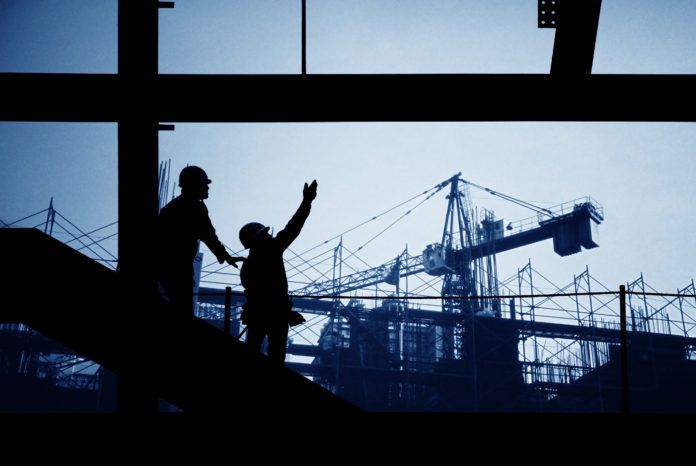April data indicated by far the fastest decline in UK construction output since the Markit/CIPs survey began 23 years ago.
The vast majority of survey respondents (86%) reported a reduction in business activity since March, reflecting widespread site closures and shutdowns across the supply chain in response to the public health emergency.
The headline seasonally adjusted IHS Markit/CIPS UK Construction Total Activity Index fell from 39.3 in March to 8.2 in April, to signal a rapid downturn in overall construction output. Moreover, the latest reading was the lowest since data was first collected in April 1997. The previous record low was 27.8 in February 2009.
All three main categories of construction work experienced a survey-record fall during April, with declines in housebuilding (7.3) and commercial activity (7.7) exceeding that for civil engineering (14.6). Lower volumes of construction output were almost exclusively attributed to business closures in April, with survey respondents often commenting on complete stoppages of activity on-site due to the COVID-19 pandemic.
Closure of merchants and stoppages of production
April data also highlighted a severe impact on construction supply chains, with closures at builders’ merchants and stoppages of manufacturing production leading to widespread supply shortages.
The latest lengthening of average lead times for the delivery of construction products and materials was by far the steepest since the survey began in April 1997. Around three-quarters of the survey panel reported longer delivery times from suppliers during April, with a lack of availability for safety products also frequently reported by construction companies.
New business volumes fell at a rapid pace in April, with the downturn by far the steepest recorded in more than two decades of data collection. Construction companies commented on the suspension of contract awards due to business closures among clients, as well as uncertainty about the duration of stoppages on-site and feasibility of starting new projects.
Meanwhile, construction firms reported that staffing had dropped sharply in April, with employees often placed on furlough until work on-site could recommence with social distancing measures. The latest survey also indicated by far the steepest decline in sub-contractor usage in the survey history.
Business expectations for the year ahead dropped slightly since March and equalled the survey-record low seen in October 2008. Construction firms widely noted concerns beyond simply re-opening sites, including cash flow difficulties across the supply chain, rising costs and severely reduced productivity.
Tim Moore, economics director at IHS Markit, which compiled the survey, said: “The rapid plunge in UK construction output during April stands out even in a month of record low PMI data for the manufacturing and service sectors. Widespread site closures and business shutdowns across the supply chain meant that vast swathes of the construction sector halted all activity in response to the COVID-19 pandemic.
“Around 86% of survey respondents reported a fall in business activity since March, while only 3% signalled an expansion. Housebuilding and commercial work were unsurprisingly the hardest hit, but civil engineering activity also fell at by far the fastest pace since the survey began in April 1997.”
Tim continued: “A drop-in construction activity of historic proportions in April looks set to be followed by a gradual re-opening of sites in the coming weeks, subject to strict reviews of safety measures.
“However, the prospect of severe disruption across the supply chain will continue over the longer-term and widespread use of the government job retention scheme has been needed to cushion the impact on employment. Looking ahead, construction companies widely commented on worries about cash flow, rising operating costs and severely reduced productivity, as well as a slump in demand for new construction projects.”
Duncan Brock, group director at the Chartered Institute of Procurement & Supply (CIPs), added: “April’s figures delivered more worrying news for fragile construction businesses as the effects of the coronavirus continued to ripple across supply chains, devastating all productivity in its wake. Though a fall in output was not a complete surprise, the scale and suddenness of the drop has knocked the wind out of building work in the UK.
“More vulnerable than other sectors that make up the UK economy, construction was unable to continue in any significant capacity, as companies grappled with furloughed staff and building sites under complete shutdown.
“Only a few civil engineering and infrastructure projects were able to continue in April, but a tentative restart is expected in other areas such as housebuilding and commercial construction in the short-term. As new plans from policymakers are developed over social distancing, building work may continue but not as we know it as restrictions and new safety rules are likely to make progress more difficult. For a sector still not fully recovered from the skills shortages created by the financial crisis in 2008, the vacuum of output created by the pandemic has knocked the sector back another decade.”
Industry reaction…
Government must stimulate demand in the sector
James Talman, chief executive of the National Federation of Roofing Contractors, said: “Construction activity has plummeted since the lockdown was announced in March, with output now the lowest the industry has seen in recent memory. While sites and manufacturers are starting to re-open, the industry is now plagued by an almost complete lack of confidence of future work.
“There is small window of opportunity for the government to act to ensure this economic hit doesn’t become a long-lasting recession. It would be a crying shame for construction to lose otherwise viable businesses and skilled workers, and to have to start rebuilding from scratch. Construction has the highest number of furloughed workers after accommodation and food, and if confidence is not restored soon, we may not see these workers return.
“Government must stimulate demand in the sector, not only by investing in infrastructure, but also by boosting housebuilding and the domestic repair and maintenance sector, which have been the worse hit. Now is also the time to invest in upskilling, to help those out of work to find new skills and ensure that the economy coming out of this, is a highly skilled and productive one.”
Government green light needed for safe return to work
Brian Berry, chief executive of the Federation of Master Builders (FMB), said: “Today’s fall in construction output matches our members’ experience of the past few months. Ninety-six percent of local builders have stopped work on-site since the coronavirus hit the UK. They’ve been unable to access materials, including personal protective equipment (PPE), and it has been challenging to maintain social distancing rules on-site that keep themselves and the public safe. Forty percent of clients have requested work to stop.”
Brian continued: “To ensure a safe return to work, and fire up construction, the public needs a clear, and joined-up, statement from government that indoor and outdoor construction is safe. Builders need guaranteed access to PPE, and we look to the government to coordinate this, so that limited PPE is not taken away from the health front line.
“In the longer-term, construction needs a clear plan for recovery – something the construction sector is working towards delivering. This must include a national retrofit strategy that harnesses capacity in the SME sector to upgrade the energy efficiency of people’s homes. It needs to tackle poor payment practises in the supply chain to support growth. And it must boost local planning departments to help local house builders bring forward new homes more quickly.”




